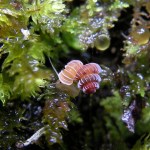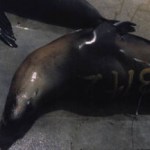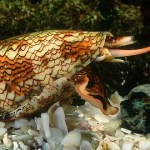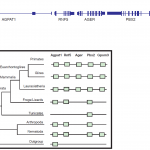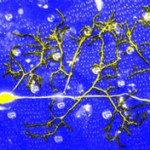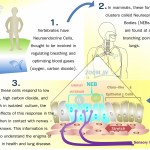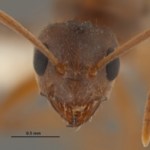Life Science
Photo Credit: Liew Thor-Seng
Ten new species of snails in the genus Plectostoma have been discovered in the limestone hills of Southeast Asia. Limestone hills are not common in this region, so the individual snail species are often isolated to just one hill. Therefore mining has threatened their existence and several species are already extinct or endangered.
Source:
LiveScience
Check out this neat video highlighting how frog-eating bats are using frog mating calls to know where to pick up dinner:
I just read a really neat study from researchers at Texas A&M University. While admittedly this is not comparative physiology, it was just too interesting not to share.
In a study published in the Journal of Nutritional Biochemistry, Dr. Luis Cisneros-Zevallos and colleagues found that administering peach extract to mice inhibited the metastasis (i.e. spread) of breast cancer to other organs, namely the lungs. They attribute this effect to the mix of phenolic compounds in the extract. The dose administered to the mice is equivalent to consuming 2-3 peaches for a human.
In prior work, Dr…
Credit: Image courtesy of Stanford University Medical Center, from ScienceDaily
According to a press release from Stanford University, California sea lions develop epilepsy from exposure to a toxin produced by algae called domoic acid. The animals develop seizures which can result in memory loss, tremors, convulsions and even death. The hippocampal region in the brain of the affected sea lions shows similar damage as humans with epilepsy, with losses of about 50 percent of neurons. Dr. Paul Buckmaster, professor of comparative medicine at Stanford was quoted as saying, "We found there was…
Here I thought snails were just cute little creatures that liked to dine in my vegetable garden. You can imagine my surprise to learn there are also carnivorous snails....with venom. New research shows that conotoxin, isolated from cone snail venom, can numb pain. Conotoxin is also reportedly 100 times more potent than morphine at treating chronic nerve pain. The added benefit is that it does not appear to be addictive.
The snail to the rescue is the marine carnivorous cone snail common to the Indian Ocean and western Pacific. It hunts by stabbing prey and injecting a venom that paralyzes…
Figure 1 showing RAGE (aka: Ager) expression only in mammals from Sessa et al., PLOS ONE. 9(1): e86903, 2014.
RAGE stands for "receptor for advanced glycation end-products", also known as "AGER", and new research shows that it first appeared in mammals (Sessa et al., 2014). Despite the name, the receptor also binds other signaling molecules such as HMGB1, S100 proteins, beta-amyloid, phosphatidylserine, among others (Xie et al., 2013). RAGE is reportedly involved in diabetes, cardiovascular disease, atherosclerosis, osteoarthritis, cancer, Alzheimer's disease, as well as liver and renal…
This adorable baby gorilla was born through emergency c-section at the San Diego Zoo Safari Park, a procedure that is not commonly performed in animals. She weighed in at 4.6 pounds. Her mother went into labor Wednesday morning but showed no progress by evening, necessitating the c-section.
The baby gorilla remains in intensive care after suffering from a collapsed lung, which she has been treated for.
Research published last month in PNAS provides evidence that African elephants (Loxodonta africana) can differentiate human voices. This is a very important skill to an animal that is often threatened by humans. Prior research has shown that elephants could tell the difference between African ethnic groups using sight and scent.
The study was conducted by Drs. Karen McComb and Graeme Shannon (University of Sussex, Brighton, UK). They recorded men from two different Kenyan ethnic groups speaking in their native language the phrase "Look, look over there, a group of elephants is coming." The…
Image from U Penn.
I came across this really interesting press release from the University of Pennsylvania that I just had to share.
Despite having a close relationship with dogs for thousands of years, we are still making new discoveries about our canine friends. Drs. William Beltran (School of Veterinary Medicine), Artur Cideciyan (Perelman School of Medicine), and colleagues teamed up to study canine eyes in an effort to improve treatments for humans with retinal diseases.
Dr. Beltran was quoted as saying “It’s incredible that in 2014 we can still make an anatomical discovery in a…
Dr. Carl Meyer (University of Hawaii) and Dr. Katsufumi Sato (University of Tokyo) have teamed up to gather data about shark behavior in a rather interesting way. They flipped the animals upside down, which makes them relax, and strapped on cameras and instruments that will facilitate the creation of 3D models of shark movements. Using accelerometers, they are able to measure speed while magnetometers record the magnetic field and additional tools measure the water temperature and depth. The video is used to help contextualize these other data.
Sources:
University of Hawaii
National…
Artist's rendition of dendrite regeneration in a fruit fly during metamorphosis. (Chay Kuo Lab, Duke University)
Researchers at Duke University are interested in understanding the metamorphosis of fruit flies from larvae to adult stage in an effort to understand how the insects grow new nerve endings as they undergo this transition. What is interesting is that the flies lose neurons they will not need as an adult and will grow new nerve endings. According to a press release from Duke University, a protein called Cysteine proteinase-1 (Cp1) is important in the regeneration step. In fact,…
Congratulations to Nicolle Domnik, this year's winner of the new Dr. Dolittle Travel Award to present her research at the annual Experimental Biology conference in San Diego, CA in April. Nicolle is currently a graduate student in the Department of Biomedical and Molecular Sciences at Queen's University in Canada. The award criteria included the submission of a guest blog entry based on the research she will be presenting at the Experimental Biology conference (N Domnik, SG Vincent, E Cutz, JT Fisher. Murine airway slowly-adapting receptor responses to lung inflation: A role for serotonin?…
A golden retriever in a fMRI scanner. Image by ENIKO KUBINYI from The Scientist.
A paper published in Current Biology describes research using functional magnetic resonance imaging (fMRI) to compare the sound processing regions of brains in humans and dogs (border collies and golden retrievers). The subjects listened to almost 300 sounds (vocalizations from dogs and humans as well as non-vocal sounds) or no sound as a control. They used the fMRI to locate sound-sensitive regions (auditory cortex) in the human and dog brains. Not surprisingly, the human auditory cortex was mostly (87%)…
Image of bonobo from Reuters. Credit: REUTERS/KATRINA MANSON/FILES
Researchers have observed that bonobos are innately able to match a beat that was created by the research team. The bonobos demonstrated their musical skills using a special drum that was created to withstand 500 pounds of pressure, chewing, etc. The favored tempo matched the cadence of human speech, about 280 beats per minute.
The ability to keep a beat is thought to be important in developing and strengthening social bonds as well as communicating. In fact, some researchers hypothesize that Neanderthals communicated using…
Talk about unique adaptations. Here is a video showing how lungfish and desert frogs are able to survive for years outside of water during periods of drought. The video also shows how thorny devils living in harsh desert environments absorb water through their skin. These adaptations may come in handy with climate change.
Crazy ant image by Joe A. MacGown with the Mississippi Entomological Museum
Tawny (or Raspberry) crazy ants (Nylanderia fulva) are an invasive ant species from South America that have been invading the United States. For some reason, the ants are attracted to electronics and have been responsible for the destruction of numerous electronic devices.
A new study shows that tawny crazy ants rub formic acid over their bodies as a shield against fire ant venom. This conclusion came after researchers observed the ants rubbing themselves with formic acid after a confrontation with fire ants (…
This animal is claimed to be the biggest living land-dwelling arthropod. In fact, this crab can reportedly drown in water. To me, its name sounds more like a fantastic dinner.
©AMNH/R. Rockwell; Figure 3 from Gormezano and Rockwell, 2013
A recent study published in Ecology and Evolution shows that polar bear diets are more adaptable than previously thought.
Researchers Linda Gormezano and Robert Rockwell analyzed the feces from polar bears (Ursus maritimus) in the western Hudson Bay area and compared their findings to a similar report from 40 years ago. The study was conducted during the ice-free season when polar bears usually hunt seals to build their annual fat reserves. Since ice is melting more rapidly, less time is available for the bears to hunt their…
Scientists have identified the origin of a genome for a specific type of transmissible cancer that has spread between dogs beginning 11,000 years ago!
I came across this interesting video today from Animal Wire that shows a population of catfish caught hunting pigeons on land:
Who knew that catfish had more in common with cats than just their whiskers.
